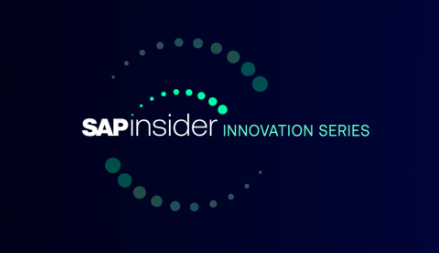SAP Supply Chain Management
SAP APO | SAP Asset Management | SAP Business Network | SAP Digital Manufacturing Cloud | SAP Digital Twin | SAP EWM | SAP IBP | SAP Inventory Management | SAP Label Printing | SAP Logistics | SAP Manufacturing | SAP Manufacturing Automation | SAP MES | SAP MII | SAP MM | SAP MRO | SAP MRP | SAP Order Management | SAP Plant Maintenance | SAP PLM | SAP Production Planning | SAP S&OP | SAP SD | SAP SPM | SAP Supply Chain Planning | SAP Track and Trace | SAP Transportation Management
Filter By
Browse By
- SAP Analytics and AI
- SAP Application Development and Integration
- All SAP Application Development and Integration
- SAP ABAP
- SAP ABAP Development Tools
- SAP ABAP Test Cockpit
- SAP API Management
- SAP BAPI
- SAP Basis
- SAP BRF
- SAP Business Application Studio
- SAP CMS
- SAP Design Studio
- SAP Development Tools
- SAP DevOps
- SAP EAI
- SAP EDI
- SAP Extension Suite
- SAP Fiori
- SAP Fiori Elements
- SAP Integration Suite
- SAP Low Code Application Development
- SAP Low Code Automation
- SAP Netweaver
- SAP Release Management
- SAP UI5
- SAP Web Application Server
- SAP Web IDE
- SAP Business Process Management
- SAP Center of Excellence
- SAP CIO
- SAP Customer Experience
- SAP Data and Data Management
- All SAP Data and Data Management
- SAP BW
- SAP BW/4HANA
- SAP Crystal Reports
- SAP Data Archiving
- SAP Data Center
- SAP Data Governance
- SAP Data Integration
- SAP Data Migration
- SAP Data Quality
- SAP Data Services
- SAP Data Strategy
- SAP Data Visualization
- SAP Data Warehouse Cloud
- SAP DMS
- SAP Document Control
- SAP EIM
- SAP ETL
- SAP ETL Tools
- SAP HANA
- SAP HANA Administration
- SAP HANA Deployment Infrastructure
- SAP HANA Studio
- SAP Master Data
- SAP Master Data Governance
- SAP MDM
- SAP Enterprise Architect
- SAP Enterprise Asset Management
- SAP ERP
- SAP Finance
- All SAP Finance
- SAP Accounting
- SAP AR AP
- SAP Asset Accounting
- SAP Billing Systems
- SAP BPC
- SAP BRIM
- SAP Cash Management
- SAP Central Finance
- SAP Controlling
- SAP COPA
- SAP Cost Center Accounting
- SAP Currency Risk
- SAP e-invoicing
- SAP FICO
- SAP Finance Automation
- SAP Advanced Financial Closing
- SAP Financial Consolidation
- SAP Financial Planning
- SAP FX Risk
- SAP General Ledger
- SAP Global Tax Management
- SAP Hyperion
- SAP Order to Cash
- SAP Payment Processing
- SAP Profitability Analysis
- SAP Rebate Management
- SAP S/4HANA Finance
- SAP SWIFT Compliance
- SAP Treasury Management
- SAP Universal Journal
- SAP Governance Risk and Compliance
- SAP Human Capital Management
- SAP Intelligent Technologies
- SAP Platform and Technology
- All SAP Platform and Technology
- SAP Business Technology Platform
- SAP Cloud
- SAP Cloud Connector
- SAP Cloud Integration Platform
- SAP Cloud Migration
- SAP Cloud Platform
- SAP Cloud Providers
- SAP Cloud Strategy
- SAP Digital Signature
- SAP Container Platform
- SAP HANA Enterprise Cloud
- SAP Digital Asset Management
- SAP Smart Forms
- SAP HEC
- SAP Digital Integration Hub
- SAP Hyperscalers
- SAP Infrastructure
- SAP Messaging
- SAP Quality and Testing
- SAP Security
- SAP Spend Management
- SAP Supply Chain Management
- All SAP Supply Chain Management
- SAP APO
- SAP Asset Management
- SAP Business Network
- SAP Digital Manufacturing Cloud
- SAP Digital Twin
- SAP EWM
- SAP IBP
- SAP Inventory Management
- SAP Label Printing
- SAP Logistics
- SAP Manufacturing
- SAP Manufacturing Automation
- SAP MES
- SAP MII
- SAP MM
- SAP MRO
- SAP MRP
- SAP Order Management
- SAP Plant Maintenance
- SAP PLM
- SAP Production Planning
- SAP S&OP
- SAP SD
- SAP SPM
- SAP Supply Chain Planning
- SAP Track and Trace
- SAP Transportation Management
- SAP System Administration
SAP Supply Chain: Supply Chain Management
A well-managed supply chain can significantly reduce a company’s operating expenses and increase profits. A supply chain requires active management because it is affected by many factors outside the control of the business. Current events causing global supply chain disruptions include the Russia-Ukraine War and the continuing effects of COVID-19.
SAP Supply Chain: Supply Chain Management
A well-managed supply chain can significantly reduce a company’s operating expenses and increase profits. A supply chain requires active management because it is affected by many factors outside the control of the business. Current events causing global supply chain disruptions include the Russia-Ukraine War and the continuing effects of COVID-19.
Supply chain management is the flow of goods or services between businesses and various locations to get goods to consumers faster and at less cost. Supply chain management encompasses a thread of activities from design and manufacturing to delivery and operations.
Components to enable a resilient and sustainable supply chain management process are:
- Designing recyclable and sustainable products
- Delivering products with low carbon impact
- Planning to reduce emissions and ethically source materials
- Operating in an energy efficient and safe manner
- Manufacturing with minimal waste and environmental impact.
Accurate information helps manufacturers and retailers produce and transport only what they can sell, eliminating unnecessary expenses. Consider simplification by integrating demand planning in the cloud. Predictive analytics, automation, and Internet of Things (IoT) technologies can connect and simplify processes, allowing you to gain visibility across forecasting, response and supply, replenishment, and inventory.
Key Capabilities of Supply Chain Management:
- Supply Chain Planning: Agile market-driven plans with visibility, collaboration, and intelligence.
- Supply Chain Logistics: Fast, efficient, and sustainable logistics.
- Manufacturing: Streamlining with artificial intelligence, loT, and integration.
- Product Lifecycle Management: Connecting systems, people, and processes with end-to-end digital innovation.
- Enterprise Asset Management: Improving asset performance and reliability.
Benefits of Supply Chain Management:
- Optimizing the flow of materials, products, and information.
- Improving data visibility.
- Enhancing financial practices and cost cutting.
- Improving vendor relationships.
- Operating with lean and on-demand inventory.
- Reducing liability and risk.
Key Considerations for SAPinsiders
- How to Deliver Greater Visibility into the Operational KPIs that Drive Your Business. In this webinar, hear insights from SAP around how to build a powerful analytics foundation. Discover how to focus less on historical KPI’s and more on predictive process automation, how to reprioritize KPIs that show historical performance, develop operational decision support for end-to-end supply chain processes, and stop development of custom reporting.
- 5 Ways to Enhance Your SCM with Smart Data. Explore expert insights from Robert Brice, President and CTO, RFgen. Start with the basics for a digital transformation of your supply chain, discover how to gain competitive advantage by implementing efficiencies, address inefficiencies, shortage of labor, and address security.
- Salling Group Expands Its Market Reach With SAP. In this article, see how Salling Group used SAP ERP to ensure data uniformity, enhance warehouse efficiency, and consolidated logistics transactions with Redwood.
558 results
-

 Premium
Premium
Start-to-Finish Guide to Creating APO DP Alerts Using Macro Builder
Reading time: 17 mins
Alerts in the planning and forecast process let you quickly identify exceptions and trends, and SAP APO allows you to create custom alerts through the Macro Builder in Demand Planning. The author expands on the SAP documentation by sharing his experience in creating DP alerts with Macro Builder. In a previous article on APO Demand...…
-

- SAP Supply Chain Management
 Premium
Premium
Cross-plant Planning in SAP S/4HANA with MRP – Part 1
Reading time: 8 mins
In cross-plant planning within S/4HANA, two primary approaches exist. One involves the utilization of the special procurement key within the MRP functionality, while the other entails employing the SAP Add-on known as cross-plant planning. This series will discuss the available options for cross-plant planning in SAP S/4HANA. Part 1 explores these options in conjunction with…
-

- SAP System Administration
 Premium
Premium
Improve Forecast Quality with Sales Forecast Collaboration Using SNC and APO
Reading time: 11 mins
Find out how you can establish a direct integration between Advanced Planning and Optimization Demand Planning and the Supply Network Collaboration sales forecast collaboration process. The integration leads to a combined forecast, an integration of data, and an improved total cost of ownership. Key Concept Supply Network Collaboration (SNC) allows business partners to align, share,...…
-
-

 Premium
Premium
Lockheed Martin Aeronautics Revolutionizes Its Supply Chain
Reading time: 8 mins
SAP S/4HANA offers enterprises tremendous potential to go beyond performance and simplicity and deliver significant business value as part of an enterprise-wide digital transformation, but this approach must be understood, considered and incorporated into by SAP and Partners SAPinsider - 2006 (Volume 7), January (Issue 1) by SAP and Partners SAPinsider - 2006 (Volume 7),…
-

Why Real-Time Inventory Visibility Enables Customer-Centric Supply Chains
Reading time: 2 mins
Real-time inventory visibility through mobile data collection solutions like RFgen’s Mobile Edge is crucial for SAP customers to enhance efficiency, customer experience, and responsiveness in supply chains, thereby gaining a competitive advantage in a customer-centric market.
-

 Premium
Premium
Eliminate SAP APO Time Zone Confusion
Reading time: 26 mins
Time zones and the added complication of Daylight Saving Time changes can confuse an SAP Advanced Planning and Optimization user. Learn the customization tasks and master data settings to keep your SAP system time settings in sync. Key Concept Time zone is both a technical and configuration parameter that is important in operating an SAP...…
-

- SAP Supply Chain Planning
 Premium
Premium
Supply Chain Planning in the Cloud
October 04, 2022
As the magnitude of challenges that supply chains face today increases in magnitude exponentially, the importance of having best-of-breed supply chain planning capabilities has increased many-fold. As organizations scramble to digitally transform their supply chains to align with the volatility they face today, supply chain planning capabilities have developed from being a portfolio of tools...…
-
-

Delivering Business Impact with SAP IBP
Reading time: 4 mins
SAP IBP is an essential component of the broader SAP S/4HANA ecosystem and has been purpose-built to help businesses of all types manage complex supply chains and streamline operations across various levels. Each module within the solution features a standardized data model, which provides real-time visibility of the supply chain. This real-time view can be…
-

SAP IBP Inventory
Reading time: 1 mins
SAP IBP Inventory is the industry leading inventory planning and optimization application capable of modeling the entire supply chain network and determining the appropriate level of inventory to maximize customer service while “fixing the mix“, resulting in significant inventory savings and ROI. Our customers typically implement IBP Inventory as part of Phase 2 of the…
-

Predicting Supply Chain Risk with Ceres AI and Boomi
February 27, 2025
The article discusses the complexities of managing supply chains amidst digital transformation and the role of Ceres AI integrated with SAP in predicting and mitigating purchase order delays, highlighting the effectiveness of Boomi’s tools in streamlining integration and enhancing decision-making.
Become a Member
Unlimited access to thousands of resources for SAP-specific expertise that can only be found here.
Become a Partner
Access exclusive SAP insights, expert marketing strategies, and high-value services including research reports, webinars, and buyers' guides, all designed to boost your campaign ROI by up to 50% within the SAP ecosystem.
Upcoming Events
Related Vendors
Your request has been successfully sent


